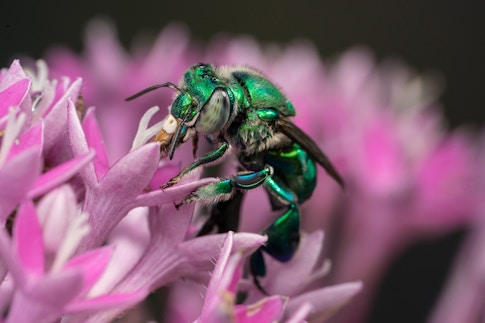Untangling the Feedback Loop Between the Genome, the Brain and Evolution

What’s the difference between a honeybee and a bumble bee? More than you might think. Indeed, they represent just two of the more than 20,000 bee species on earth, all of which have their own unique behaviors. For his masters and doctoral work, Philipp Brand, a Junior Fellow with the Simons Society of Fellows, studied the genetic underpinnings of the sex pheromones of orchid bees, which thrive in tropical climates. This research informed his current postdoctoral focus on evolutionary neuroscience, which explores how nervous systems adapt over time to generate variation in behavior across animal species. In his work in Vanessa Ruta’s lab at Rockefeller University, Brand studies these questions in the drosophila fruit fly. He eventually plans to integrate his research interests in his own lab, with a joint focus on genomics and evolutionary neuroscience.
Brand holds a bachelor’s degree in biology and master’s in genetics from Heinrich Heine University in Düsseldorf, Germany, and a doctorate in population biology from the University of California, Davis. We recently discussed his career arc, current pursuits and long-term plans. Our conversation has been edited for clarity.
What drew you to the study of evolutionary behavioral genetics?
During my time as an undergraduate in Germany, I took a class in insect biodiversity and was immediately hooked; I even became a teaching assistant for that same class the following year. I’m fascinated by the fact that there are so many different types of insects on the planet, with so much genetic and behavioral diversity. How did this diversity evolve? My entire career has been focused on understanding the principles driving this evolutionary biodiversity. And it turned out that orchid bees, which were the focus of my graduate work, are not only gorgeous to look at but also excellent animals to study for this purpose.

Why are orchid bees so compelling?
When I was young, I was interested in ants, but as an undergraduate student I learned that bees display similarly complex and advanced social behaviors. My newfound interest in bees was supported by the professor who taught the biodiversity course I mentioned, and finally culminated with my focus on orchid bees.
Orchid bees have a fascinating pheromone system that males use for courting females. To get the female’s attention, males travel through the rain forest collecting scents from flowers and other sources — the aggregate of which is called a “perfume” — that they store in their hind legs and later release in hopes of attracting the perfect mate. Many of these aromatic compounds are collected on orchids — giving the bee its name — and each orchid bee species collects their own distinguished perfume mixture. This allows females to find the right mate, and males to tell each other apart.
Both males and females use receptors in their antennae (which act like an insect’s “nose”) to detect perfumes, but just one mutation in these receptors can change both the male’s and the female’s ability to perceive the right perfume and its individual compounds. This change can affect the courtship process profoundly: It can lead to males collecting different compounds than they otherwise would, while females in turn might be attracted to these new, different perfumes. We think that this is one way that perfumes can evolve, thereby contributing to the formation of novel orchid bee species. For my doctoral work I studied the genetics of this process — which had never been studied before — and how it has evolved over time.
What did you learn?
My research took me to Central America, where orchid bees thrive. I studied two different, but closely related, orchid bee species: Euglossa dilemma and E. viridissima. I was hoping to answer two questions: What were the genetic differences that caused these species to diverge, and did that genetic variance cause the divergence in each species’ perfume?
I collected hundreds of bees, sequenced their genomes and conducted a chemical analysis of variations between each species’ perfume. While the perfumes differed between species, the bees’ genomes were highly similar to each other, with one exception: those genes that encoded receptors related to smell. This finding was exciting, because of the important part that the sense of smell plays in perfume collection and detection.
To further test this, I examined what smells these receptors can detect. I found that the receptors that are most genetically divergent between the species differed in the smells they can detect; they responded specifically to components of their own perfume. This result provided a genetic explanation for how orchid bee species evolve. Indeed, the diversification of smell receptors might be a crucial step in the evolution of the perfume composition and female preference, thus leading to novel mate choices — and eventually new species.
How exciting! What are you working on now, during your postdoctoral appointment?
Recently I expanded my interests into the genetic underpinnings of behavior. It seems like everything I was focused on during graduate school comes back to behavior. The choices that orchid bees make in selecting a mate in response to pheromone signals are guided by the animal’s central nervous system, which in turn regulates its actions.
In the Ruta lab here at Rockefeller I am working to connect my expertise in evolutionary biology with the neuroscience expertise of the lab. My goal is to understand how the nervous system evolves novel behaviors. That’s ambitious, but also extremely satisfying and enjoyable.
These days I work with fruit flies rather than orchid bees. The advanced genetic tools of drosophila can help me identify which changes in the nervous system may underlie changes in behavior across species. My specific interests are still about understanding how mating behaviors evolve and contribute to speciation. But what is really intriguing about evolutionary neuroscience is that comparing the nervous systems of different fruit fly species has the potential to uncover new features of how the brain functions, especially those that might have been overlooked. These interspecies differences are likely to have evolutionary roots. I am not only excited about what the brain can teach us about evolution but also what evolution can teach us about the brain.
Recently I compared mating behaviors across a group of nine closely related drosophila species and discovered one species that only courts and mates when food is present. How did this species evolve a dependence on food for sex? We see in many animals — and humans — that mood and different behaviors, including sexual behavior, can depend on the availability of food and hunger levels, so this is a question with a broader appeal.
Through behavioral experiments coupled with manipulations of the fly species’ sense of smell, I found that the activity of sensory cells underlying their sense of smell drive male’s reproductive behaviors. You may think that the way to a fly’s heart is through its stomach, but instead I found that it is the smell of the food that is important, not the taste! I am now working to identify the sensory and neuronal circuitry guiding this species’ behavior and how that circuitry differs compared to closely related species. My hope is that this will show me where exactly in the fly’s brain evolution branched off to give rise to this novel behavior.
What’s next after your postdoctoral fellowship?
My long-term ambition is to focus on the intersection between behavior, genetics and genomics, evolutionary biology, and neuroscience. I think that an integrative research program like this would be extremely well-suited to study how behavior evolves, as well as how brains function to lead to appropriate, species-specific behaviors. My research will continue to focus on insects, specifically flies, but who knows, maybe I’ll get back to bees someday.
Finally, how has the Simons Junior Fellowship helped your work?
The pandemic made it harder to make connections with colleagues after my transition to neuroscience than it would have been in different circumstances, but thankfully, seminars, meetings and conferences are happening again, and I can slowly connect — or reconnect — with others in my field and other Junior Fellows. This time apart has made it even more obvious to me that so much of science is taking the time to meet people and being willing to learn from experts in other fields; to integrate their knowledge into your own work. One great thing about the Simons Society of Fellows is the intellectual exchange with people in fields well beyond my own, from astrophysics to mathematics. Being a part of this community has helped me appreciate the sheer joy of learning something entirely new.